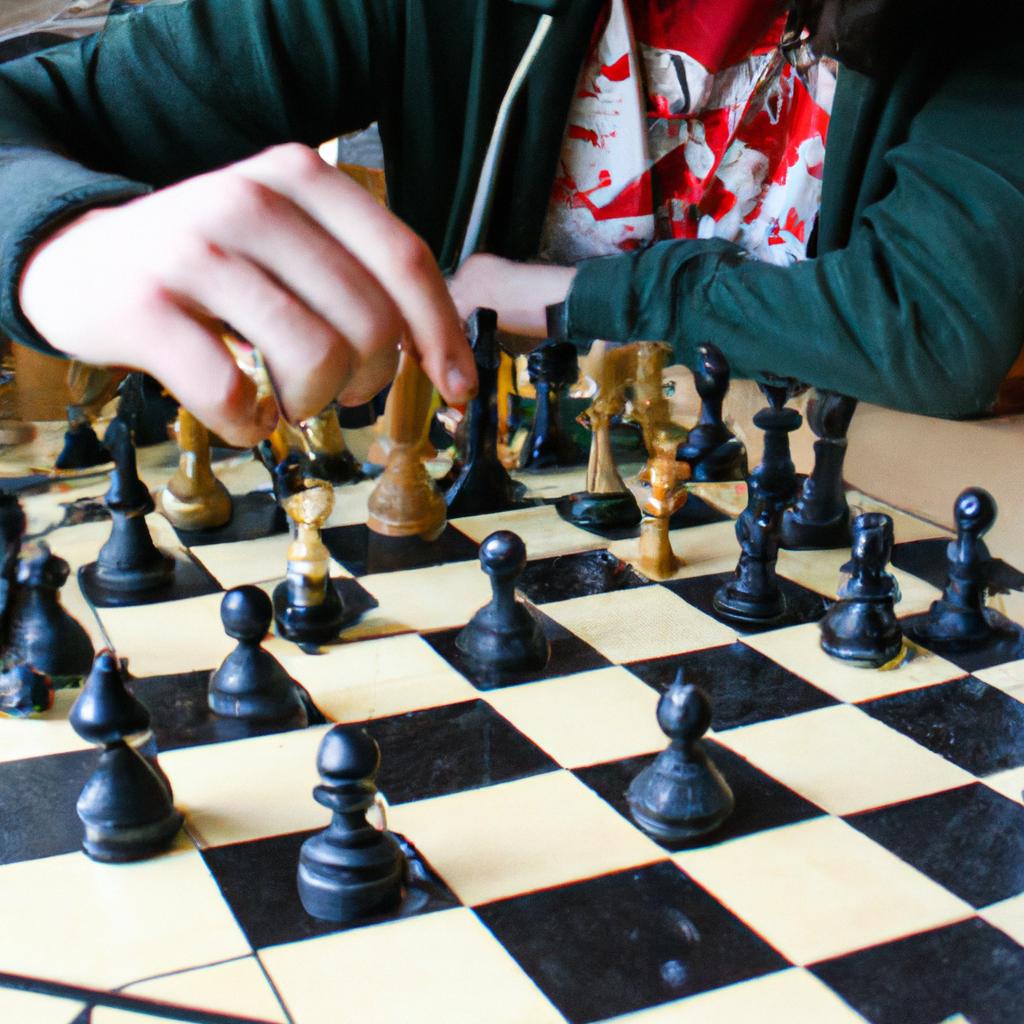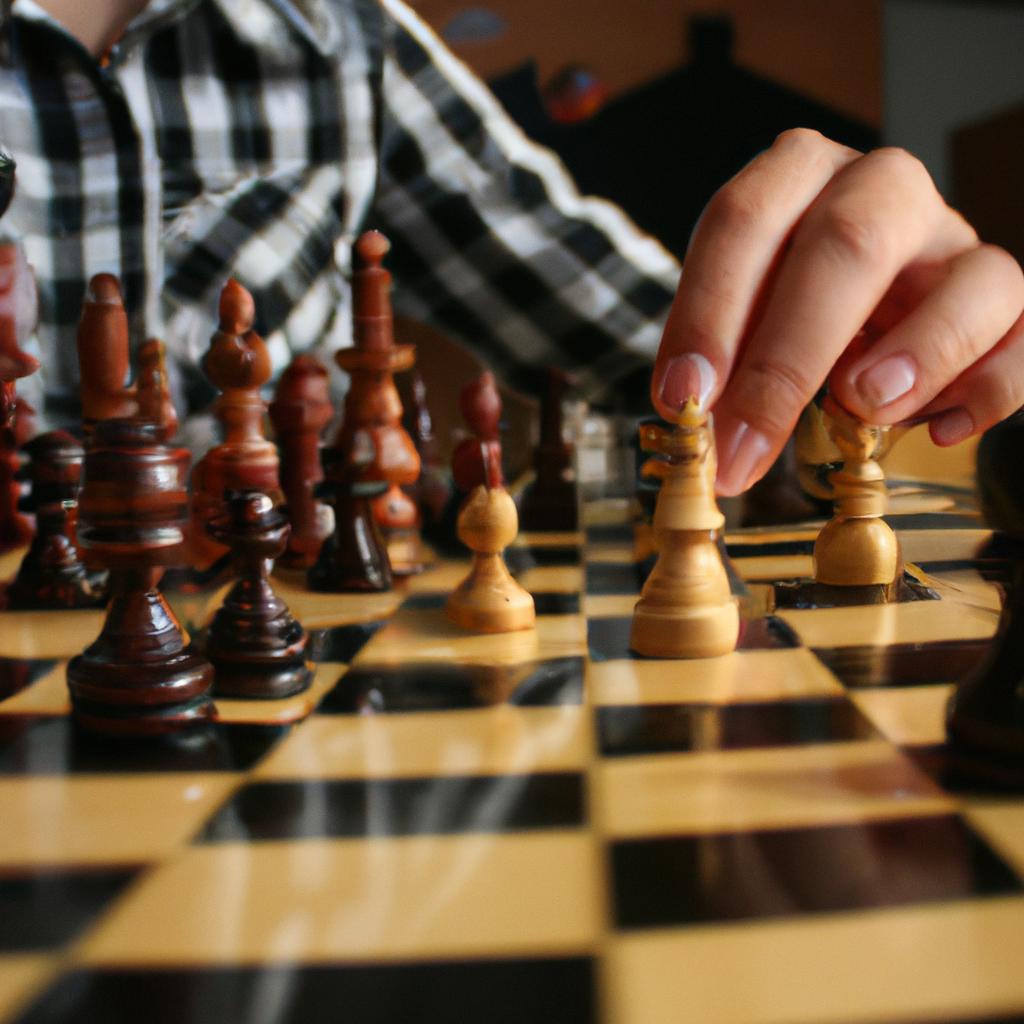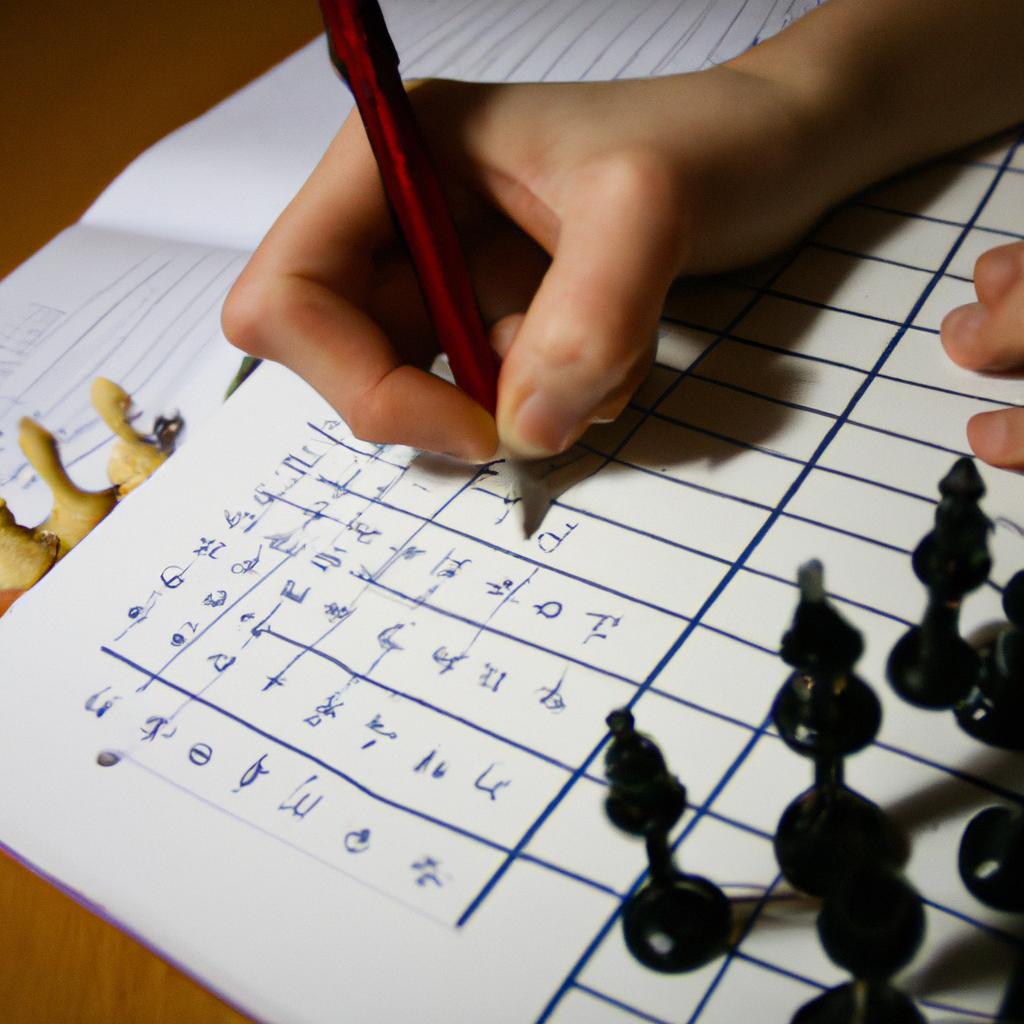Consider a scenario in which two chess players are locked in an intense battle, with both sides employing their strategic prowess to gain the upper hand. As the game progresses, pieces are captured and positional advantages shift back and forth. However, it is often during the endgame phase that true mastery of the game is showcased. This critical stage, where only a few pieces remain on the board, requires precise calculations and deep understanding of various strategies to secure victory. In this article, we delve into the world of endgame strategies in chess and explore how they can be applied not only to games but also to other sports.
The art of endgame strategies in chess holds immense significance for players aiming for triumph over their opponents. It involves making crucial decisions regarding piece activity, pawn promotion, king safety, and maneuvering techniques when faced with limited resources. For instance, imagine a hypothetical situation wherein one player possesses a rook while their opponent has a lone bishop remaining on an open board. The player with the rook must skillfully navigate towards checkmate by exploiting their advantageous position while avoiding potential stalemates or blunders that may arise due to insufficient material presence.
Endgame strategies extend beyond chess alone; they find application in various sports as well. Just like chess players Just like chess players strategically plan their moves in the endgame to secure victory, athletes in sports such as basketball, soccer, or American football also employ endgame strategies to maximize their chances of winning. These strategies involve making calculated decisions regarding game management, clock control, player substitutions, and tactical maneuvers when the outcome of the game hangs in the balance.
In basketball, for example, teams often employ different offensive and defensive strategies during the final minutes of a close game. They may focus on running plays that exploit mismatches or utilize specific players’ strengths to create scoring opportunities. On defense, teams may choose to apply full-court pressure or implement zone defenses to disrupt their opponents’ flow and force turnovers.
Similarly, in soccer, teams may adopt different formations and tactics during the closing stages of a match to protect a lead or mount a comeback. Coaches may instruct their players to play more conservatively by prioritizing ball possession and defensive solidity or push forward aggressively with an all-out attacking approach.
In American football, coaches carefully manage the clock during crucial moments at the end of a game. They strategize when to call timeouts, whether to attempt field goals or go for touchdowns, and how to effectively use their remaining possessions while considering the scoreline and time remaining.
Overall, just as chess players showcase their mastery in the endgame phase by employing strategic calculations and deep understanding of various tactics, athletes in other sports also rely on endgame strategies to secure victory. The ability to make precise decisions under pressure and leverage limited resources is a testament to true mastery of any competitive endeavor.
Understanding the importance of endgame in chess
Understanding the Importance of Endgame in Chess
Chess is a game that requires strategic planning, tactical thinking, and foresight. While all stages of a chess game are important, the endgame holds a special place due to its unique characteristics and potential for decisive outcomes. To illustrate this point, let us consider a hypothetical scenario where two skilled players find themselves in the endgame phase.
Imagine a tense match between two grandmasters reaching its climax. The board is nearly empty, with only a few pieces remaining on each side. Both players have invested countless hours studying opening tactics and mid-game strategies. However, it is during the endgame that their true skills will be put to the test. The outcome hangs precariously as they maneuver their pawns and kings across the battlefield.
The importance of mastering endgame techniques cannot be overstated. Here are four compelling reasons why understanding the intricacies of this stage can significantly impact your chances of success:
- Endgames often require precise calculations: With fewer pieces on the board, every move becomes crucial. A minor miscalculation or oversight can quickly lead to defeat or missed opportunities.
- Endgames demand accurate evaluations: Assessing various positions accurately becomes essential when making decisions about sacrificing material or pushing for an advantage.
- Endgames rely heavily on strategy: Strategic planning plays a pivotal role in determining optimal piece placement and pawn structure during this critical phase.
- Endgames offer diverse possibilities: Despite having fewer options compared to earlier stages of the game, there exist numerous creative ways to outmaneuver opponents and secure victory.
To further emphasize these points, consider Table 1 below which showcases different types of endgames along with key considerations for each type:
Table 1: Types of Endgames and Key Considerations
| Type | Key Considerations |
|---|---|
| Pawn Endings | Promotion potential |
| Rook Endings | Seventh rank control, active rook placement |
| Queen Endings | King safety, material advantage |
| Minor Piece | Bishop pair synergy, knight outpost |
As we delve deeper into the intricacies of endgame play in subsequent sections, it becomes evident that analyzing key principles and techniques is essential for any aspiring chess player. By understanding the importance of this stage and mastering its nuances, one can gain a significant advantage over opponents who overlook or underestimate the power of the endgame.
Transitioning seamlessly to our next section on “Analyzing Key Endgame Principles and Techniques,” let us explore various strategies employed by experienced players to achieve success in this critical phase of the game.
Analyzing key endgame principles and techniques
Transitioning from our previous exploration of the importance of endgame in chess, let us now delve into a comprehensive analysis of key principles and techniques that can enhance one’s mastery of this critical phase. To illustrate these concepts, we will consider a hypothetical scenario where two expert players find themselves locked in an intense battle during the final stages of a tournament match.
In this hypothetical case, both players have reached the endgame with limited material on the board – only kings and pawns remain. The player controlling the white pieces possesses a slight advantage due to his centralized king and more advanced pawn structure. However, as we shall see, even seemingly small advantages can significantly impact the outcome of the game at this stage.
To navigate through the complexities of endgames effectively, players should bear in mind several fundamental principles:
- King activity: Ensuring optimal positioning for your king is vital; it allows you to control essential squares while simultaneously safeguarding your own pawns.
- Pawn promotion: Strategically pushing pawns towards promotion becomes crucial in securing an advantageous position or creating threats that force concessions from your opponent.
- Piece coordination: Coordinating your remaining pieces efficiently enables greater tactical possibilities while restricting your adversary’s options.
- Calculation skills: Precise calculation plays a pivotal role in assessing variations and anticipating potential outcomes when making critical decisions.
Illustrating these principles further, let us examine their application within the context of our hypothetical scenario using a table:
| Principle | Application | Effect |
|---|---|---|
| King Activity | Centralizing the king | Greater control over strategic squares |
| Connecting rook and king | Improves piece coordination | |
| Pawn Promotion | Advancing passed pawns | Creates winning chances |
| Creating pawn breakthroughs | Forces decisive exchanges |
By applying these principles strategically, players can maximize their chances of achieving victory even in seemingly equal endgame positions. The hypothetical scenario above highlights how key principles such as king activity and pawn promotion can influence the outcome of a match.
To further develop our understanding of effective endgame strategies, we will explore proactive approaches that players can employ to gain an advantage during this pivotal phase. Transitioning seamlessly into our next section, let us now embark on the journey towards developing a proactive endgame strategy.
Developing a proactive endgame strategy
Transitioning from the previous section, where we delved into analyzing key endgame principles and techniques, let us now explore the importance of developing a proactive endgame strategy. To illustrate this concept, consider the following scenario: two chess players are in an intense endgame phase with limited pieces on the board. Player A has a slight material advantage but lacks a clear plan to convert it into victory. On the other hand, Player B recognizes the significance of implementing a proactive approach by actively coordinating their remaining forces towards creating threats and exploiting weaknesses.
Developing a proactive endgame strategy is crucial for maximizing one’s chances of success. By taking control of the game and dictating its flow, a player can apply pressure on their opponent while also setting up potential tactical opportunities. Here are some key aspects to consider when formulating such strategies:
-
Centralization and activation of remaining pieces: In order to exert influence over critical areas of the board, it is essential to centralize and activate your remaining pieces effectively. This involves maneuvering them towards optimal squares that allow for greater mobility and attacking possibilities.
-
Targeting weak pawns or targets: Identifying weak points in your opponent’s position provides an opportunity to exploit vulnerabilities. Focusing your efforts on undermining these weaknesses can lead to significant advantages, such as gaining material or positional superiority.
-
Coordination between different resources: The coordination between various elements at play – like king, pawn structure, minor pieces, etc.– is vital for executing effective maneuvers and consolidating strategic initiatives.
-
Effective time management: Time is a valuable resource during endgames, especially given fewer pieces available compared to earlier stages of the game. Efficiently managing time ensures that you maintain control over important transitions and avoid unnecessary mistakes due to time pressure.
To emphasize further how developing a proactive endgame strategy can impact outcomes significantly, let us look at an illustrative table showcasing hypothetical scenarios:
| Situation | Consequence |
|---|---|
| Player A takes a passive approach, focusing on defense without any clear plan. | Player B seizes the initiative by actively coordinating their remaining forces and exploiting weaknesses. |
| Player A fails to centralize pieces effectively or target weak points in opponent’s position. | Player B gains material superiority and creates tactical opportunities that lead to victory. |
In conclusion, developing a proactive endgame strategy can be the difference between success and defeat in chess games and other strategic sports. By taking control of the game’s flow, targeting weaknesses, coordinating resources, and managing time efficiently, players increase their chances of emerging victorious. With this understanding of how proactive strategies impact outcomes positively, we now turn our attention to exploring the next section: “Exploiting tactical opportunities to gain an advantage.”
Exploiting tactical opportunities to gain an advantage
Transitioning smoothly from the previous section on developing a proactive endgame strategy, let us now explore another crucial aspect of mastering chess in games and sports: exploiting tactical opportunities to gain an advantage. To illustrate this concept, consider the following scenario:
Imagine you are playing a game of chess against a formidable opponent who has managed to maintain strong defenses throughout most of the match. However, during the endgame phase, you notice a slight weakness in their position – their king is left slightly vulnerable due to an exposed pawn structure. This presents a golden opportunity for you to strike and potentially secure victory.
To effectively exploit such tactical opportunities in the endgame, it is essential to keep certain strategies in mind:
-
Calculation and Visualization: Accurately calculating potential moves and visualizing possible outcomes can help identify tactical opportunities that may arise during the endgame. By analyzing variations and foreseeing consequences several moves ahead, players can spot moments when they have the chance to capitalize on weaknesses or create unexpected threats.
-
Piece Coordination: In order to maximize your chances of exploiting tactical opportunities in the endgame, coordinating your pieces becomes vital. Properly positioning your pawns and other remaining pieces allows for effective collaboration towards achieving strategic objectives. A well-coordinated attack can put pressure on key squares or threaten decisive checks that force favorable exchanges.
-
Time Management: The limited number of remaining pieces in the endgame means that time management becomes even more critical. Players must carefully utilize their remaining time allotment by focusing on key positions while also keeping track of their opponent’s counterplay possibilities.
-
Prophylactic Moves: Employing prophylactic moves can be instrumental in preventing potential counterattacks or reducing any risks posed by opposing forces. By anticipating possible tactics from one’s opponent and taking preemptive measures to neutralize them, players can solidify their own position while simultaneously limiting their adversary’s options.
Table example:
| Strategies for Exploiting Tactical Opportunities in the Endgame |
|---|
| 1. Calculation and Visualization |
| 2. Piece Coordination |
| 3. Time Management |
| 4. Prophylactic Moves |
By incorporating these strategies into your gameplay, you can enhance your ability to exploit tactical opportunities during the endgame phase, potentially turning the tide of a game in your favor. Mastering this aspect of chess not only requires understanding different tactics but also developing foresight and adaptability.
Transitioning smoothly into our subsequent section about “Mastering pawn endgames for crucial wins,” let us now delve further into another fundamental element of achieving success in chess games and sports.
Mastering pawn endgames for crucial wins
Exploiting tactical opportunities to gain an advantage can be a powerful strategy in chess. By carefully analyzing the position and identifying potential weaknesses, players can create tactical combinations that lead to significant advantages. Let’s explore this concept further by considering an example:
Imagine a hypothetical scenario where Black has just moved their knight to attack White’s queen. At first glance, it may seem like White is at a disadvantage. However, upon closer examination, there is a tactical opportunity available for White to exploit. By sacrificing their queen with a brilliant combination involving multiple pieces, White can secure a checkmate against Black within the next few moves.
When it comes to exploiting tactical opportunities, certain guidelines can prove useful:
- Stay alert: Vigilance is key in spotting potential tactics. Constantly reassess the board and look for any positional weaknesses or unprotected pieces.
- Calculate variations: Before executing any tactical move, calculate various possible continuations in your mind. Assess both short-term gains and long-term consequences of each move.
- Evaluate risks: While seizing opportunities is essential for success, it’s important to assess the risks involved as well. Avoid overly speculative sacrifices that could leave you at a greater disadvantage if they fail.
- Maintain flexibility: Adaptability is crucial when exploiting tactical opportunities since positions are constantly changing. Be open-minded and consider alternative plans if new possibilities arise during gameplay.
To illustrate these concepts more clearly, let us examine the following table showcasing some common tactical motifs found in chess:
| Motif | Description | Example |
|---|---|---|
| Fork | Simultaneously attacking two or more opponent’s pieces | Knight forks enemy king and rook |
| Pin | Restricting movement of an opponent’s piece | Bishop pins enemy knight to king |
| Skewer | Attacking one piece while simultaneously threatening another behind it | Rook skewers enemy queen and king |
| Discovered Attack | Revealing an attack by moving one piece, uncovering the attack of another | Bishop moves to reveal rook’s assault |
By understanding these tactical motifs and incorporating them into their gameplay, chess players can enhance their ability to exploit opportunities and gain a significant advantage on the board.
Moving forward, our next section will delve into mastering pawn endgames for crucial wins. In this segment, we will explore various strategies and techniques specifically tailored for navigating the complexities of pawn-based endgame scenarios. So let us now turn our attention towards utilizing piece coordination for a decisive endgame.
Utilizing piece coordination for a decisive endgame
Building on the mastery of pawn endgames, this section delves into the importance of utilizing piece coordination to achieve a decisive endgame advantage. By strategically coordinating the movements and interactions between different pieces, players can increase their chances of securing victory in chess games and other sports.
Piece Coordination for Decisive Endgames
One example that highlights the significance of piece coordination is when a player effectively combines their rook and bishop to create a deadly attacking duo. This partnership allows for a powerful combination of long-range attacks from the rook, supported by the diagonal influence of the bishop. By coordinating these two pieces harmoniously, players gain control over key squares and lines on the board, leading to increased pressure on their opponent’s position.
To master piece coordination for decisive endgames, consider employing these strategies:
-
Proactive Planning: Anticipate future moves and plan your piece placement accordingly. Identify potential weaknesses in your opponent’s defense and aim to capitalize on them through coordinated attacks using multiple pieces.
-
Centralization: Positioning your pieces centrally provides better mobility and flexibility during an endgame. Aim to centralize your most active pieces such as knights, bishops, or even queen (if it won’t be vulnerable) to maximize their impact on the game.
-
Defense-Offense Balance: Maintain a balance between defensive responsibilities and offensive opportunities while coordinating your pieces. Ensuring that each piece contributes meaningfully both defensively and offensively enhances overall synergy among them.
-
Timing: Proper timing is crucial when executing coordinated maneuvers with multiple pieces. Patience is vital – waiting for opportune moments rather than rushing blindly into aggressive actions may yield more favorable outcomes in critical positions.
Table: Illustration of Coordinated Piece Movements
| Pieces | Coordinated Movement |
|---|---|
| Queen-Rook | Vertical or horizontal line dominance |
| Bishop-Knight | Diagonal control with tactical possibilities |
| Queen-Bishop | Diagonal or central square domination |
| Rook-Knight | Tactical attacks on weak spots |
By embracing the concepts of piece coordination and implementing these strategies effectively, players can enhance their endgame skills. The ability to seamlessly integrate multiple pieces in a coordinated manner not only strengthens one’s position but also puts pressure on opponents, creating opportunities for decisive victories.
Overall, mastering piece coordination is an integral aspect of achieving success in chess games and other sports where strategic thinking plays a vital role. By understanding the significance of each piece’s movement patterns and learning how to synchronize them harmoniously, players gain a competitive edge that can lead to triumphs on the board.









